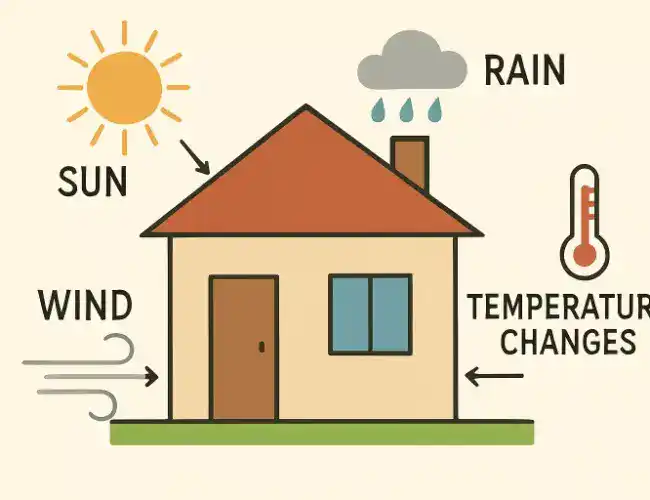Extreme weather conditions significantly affect how well a painted surface holds up over time. Sun exposure, heavy rainfall, humidity, and temperature fluctuations can all impact the durability of a home’s exterior finish. UV rays, for instance, can cause fading and chalking, while moisture can lead to blistering, peeling, or mold growth if surfaces aren’t properly sealed or maintained.
Because of these environmental factors, proper surface preparation and material selection are essential in any exterior painting project. High-quality paints designed for specific climates can better resist damage and help preserve a home’s appearance longer. Regular maintenance, like cleaning and touch-ups, also prolongs the finish, especially in areas prone to harsh seasonal changes.
Sunlight and UV Exposure
Sunlight significantly threatens exterior paint, especially in sunny or high-altitude areas. UV rays cause fading, bleaching, and chalkiness, weakening the paint by breaking down chemical bonds, making it brittle and prone to cracking or peeling. Darker shades suffer more due to heat absorption. To protect paint, use high-quality UV-resistant or exterior paints with additives that resist solar damage. Applying a clear UV-protective topcoat adds extra protection.
Moisture and Humidity
Water from rain, humidity, or dew can weaken paint if surfaces aren’t protected. Moisture seeps into cracks, causing blistering, bubbling, and peeling, especially on wood, stucco, or old siding. It also promotes mold, mildew, and algae, staining surfaces and damaging substrates, possibly leading to rot and structural damage. To prevent this, prepare surfaces by cleaning and drying thoroughly, removing loose paint, and sealing cracks. Use moisture-resistant primers and paints, and inspect vulnerable areas after wet seasons, addressing issues promptly. Reputable exterior products can provide excellent, weatherproof protection.

Temperature Fluctuations
Frequent temperature fluctuations represent a hidden threat to the longevity of exterior paint. Materials like wood and siding expand and contract as temperatures change. This constant movement stresses the paint layer, making it susceptible to splitting, flaking, and detaching. This effect is particularly pronounced in climates that experience significant daily or seasonal temperature swings, where paint can lose flexibility. As a result, cracking may occur prematurely, leading to the need for touch-ups or complete recoating.
Wind and Debris
Wind often damages painted exteriors by blowing dust, grit, and particles that wear away surfaces and increase moisture absorption. Coastal winds with salt can weaken paint and cause flaking, while debris chips paint on ledges and trim, risking further damage. To protect against wind, use durable, exterior-specific paints with a thick finish, and consider sealants in windy or salty areas. Regularly washing siding helps remove dirt, salt, and pollution, extending paint life.
Choosing the Right Paint
The longevity of any paint job depends on the initial paint and primer choice, considering the climate. For sunny areas, choose UV-resistant paints; for damp regions, use water and mildew-resistant paints. Acrylic latex paints are preferred for durability, flexibility, and water shedding. Select paints that withstand temperature shifts without cracking or peeling after freeze-thaw cycles in cold climates. Always match paint and primer to your environment and building materials.
Proper Surface Preparation
The performance of paint depends on the surface it’s applied to. Start by thoroughly cleaning the surface using a pressure washer or soapy water to remove dust and mildew, and let it dry completely to avoid peeling or bubbling later.
Next, repair any imperfections like cracks or holes, and sand rough surfaces for better adhesion. Use a quality primer suitable for the wall material and your paint choice. Apply thin, even coats with good brushes or rollers for the best results. Proper preparation is crucial for maximizing the paint’s durability and effectiveness.